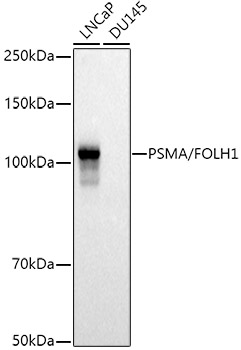
Flow cytometry analysis of GCPII (PSMA) by various monoclonal antibodies: GCP-01, GCP-02, GCP-04, GCP-05 (GTX80149) on LNCaP cell line. Legend: green column - 1 microg/ml, LNCaP cell line blue column - 5 microg/ml, LNCaP cell line yellow column - negative cell line
PSMA antibody [GCP-05] (PE)
GTX80150
ApplicationsFlow Cytometry
Product group Antibodies
ReactivityHuman
TargetFOLH1
Overview
- SupplierGeneTex
- Product NamePSMA antibody [GCP-05] (PE)
- Delivery Days Customer9
- ApplicationsFlow Cytometry
- CertificationResearch Use Only
- ClonalityMonoclonal
- Clone IDGCP-05
- Concentration0.1 mg/ml
- ConjugateRPE
- Gene ID2346
- Target nameFOLH1
- Target descriptionfolate hydrolase 1
- Target synonymsFGCP, FOLH, GCP2, GCPII, NAALAD1, PSM, PSMA, mGCP, glutamate carboxypeptidase 2, N-acetylated alpha-linked acidic dipeptidase 1, N-acetylated-alpha-linked acidic dipeptidase I, NAALADase I, cell growth-inhibiting gene 27 protein, folylpoly-gamma-glutamate carboxypeptidase, glutamate carboxylase II, glutamate carboxypeptidase II, membrane glutamate carboxypeptidase, pteroylpoly-gamma-glutamate carboxypeptidase
- HostMouse
- IsotypeIgG1
- Protein IDQ04609
- Protein NameGlutamate carboxypeptidase 2
- Scientific DescriptionThis gene encodes a type II transmembrane glycoprotein belonging to the M28 peptidase family. The protein acts as a glutamate carboxypeptidase on different alternative substrates, including the nutrient folate and the neuropeptide N-acetyl-l-aspartyl-l-glutamate and is expressed in a number of tissues such as prostate, central and peripheral nervous system and kidney. A mutation in this gene may be associated with impaired intestinal absorption of dietary folates, resulting in low blood folate levels and consequent hyperhomocysteinemia. Expression of this protein in the brain may be involved in a number of pathological conditions associated with glutamate excitotoxicity. In the prostate the protein is up-regulated in cancerous cells and is used as an effective diagnostic and prognostic indicator of prostate cancer. This gene likely arose from a duplication event of a nearby chromosomal region. Alternative splicing gives rise to multiple transcript variants encoding several different isoforms. [provided by RefSeq, Jul 2010]
- ReactivityHuman
- Storage Instruction2°C to 8°C
- UNSPSC12352203








![IHC-P analysis of human prostate tissue using GTX01882 PSMA antibody [1D6].](https://www.genetex.com/upload/website/prouct_img/normal/GTX01882/GTX01882_20200811_IHC-P_77_w_23053121_883.webp)